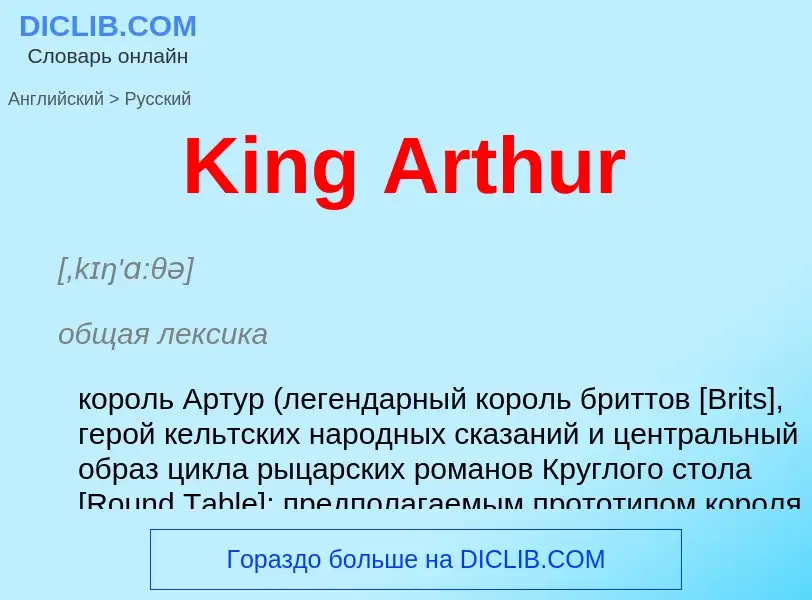Translation and analysis of words by ChatGPT artificial intelligence
On this page you can get a detailed analysis of a word or phrase, produced by the best artificial intelligence technology to date:
- how the word is used
- frequency of use
- it is used more often in oral or written speech
- word translation options
- usage examples (several phrases with translation)
- etymology
King Arthur - translation to russian
[,kɪŋ'ɑ:θə]
общая лексика
король Артур (легендарный король бриттов [Brits], герой кельтских народных сказаний и центральный образ цикла рыцарских романов Круглого стола [Round Table]; предполагаемым прототипом короля Артура был вождь силуров, живший в 6 в.)
прилагательное
общая лексика
Arthurian romances - [лит.] романы Артурова цикла (по легендам о короле Артуре)
Definition
Wikipedia

King Arthur (Welsh: Brenin Arthur, Cornish: Arthur Gernow, Breton: Roue Arzhur) is a legendary king of Britain, and a central figure in the medieval literary tradition known as the Matter of Britain. In Welsh sources, Arthur is portrayed as a leader of the post-Roman Britons in battles against Anglo-Saxon invaders of Britain in the late 5th and early 6th centuries. He first appears in two early medieval historical sources, the Annales Cambriae and the Historia Brittonum, but these date to 300 years after he is supposed to have lived, and most historians who study the period do not consider him a historical figure. His name also occurs in early Welsh poetic sources such as Y Gododdin. The character developed through Welsh mythology, appearing either as a great warrior defending Britain from human and supernatural enemies or as a magical figure of folklore, sometimes associated with the Welsh otherworld Annwn.
The legendary Arthur developed as a figure of international interest largely through the popularity of Geoffrey of Monmouth's fanciful and imaginative 12th-century Historia Regum Britanniae (History of the Kings of Britain). Geoffrey depicted Arthur as a king of Britain who defeated the Saxons and established a vast empire. Many elements and incidents that are now an integral part of the Arthurian story appear in Geoffrey's Historia, including Arthur's father Uther Pendragon, the magician Merlin, Arthur's wife Guinevere, the sword Excalibur, Arthur's conception at Tintagel, his final battle against Mordred at Camlann, and final rest in Avalon. The 12th-century French writer Chrétien de Troyes, who added Lancelot and the Holy Grail to the story, began the genre of Arthurian romance that became a significant strand of medieval literature. In these French stories, the narrative focus often shifts from King Arthur himself to other characters, such as various Knights of the Round Table. The themes, events and characters of the Arthurian legend vary widely from text to text, and there is no one canonical version. Arthurian literature thrived during the Middle Ages but waned in the centuries that followed, until it experienced a major resurgence in the 19th century. In the 21st century, the legend continues to have prominence, not only in literature but also in adaptations for theatre, film, television, comics and other media.


![Mount Badon]]" 1898 Mount Badon]]" 1898](https://commons.wikimedia.org/wiki/Special:FilePath/Arthur Leading the Charge at Mount Badon.png?width=200)


![King Arthur (holding Excalibur) and Patsy in ''[[Spamalot]]'', a stage musical adaptation of the 1975 film ''[[Monty Python and the Holy Grail]]'' King Arthur (holding Excalibur) and Patsy in ''[[Spamalot]]'', a stage musical adaptation of the 1975 film ''[[Monty Python and the Holy Grail]]''](https://commons.wikimedia.org/wiki/Special:FilePath/Excalibur-spam.jpg?width=200)
![Supposed former gravesite of Arthur at [[Glastonbury Abbey]] Supposed former gravesite of Arthur at [[Glastonbury Abbey]]](https://commons.wikimedia.org/wiki/Special:FilePath/Former Gravesite King Arthur (GlastonburyAbbey).jpg?width=200)

![King Arthur in a 15th-century Welsh version of ''[[Historia Regum Britanniae]]'' King Arthur in a 15th-century Welsh version of ''[[Historia Regum Britanniae]]''](https://commons.wikimedia.org/wiki/Special:FilePath/History of the Kings (f.75.v) King Arthur.jpg?width=200)


!["Arturus rex" (King Arthur), a 1493 illustration from the ''[[Nuremberg Chronicle]]'' "Arturus rex" (King Arthur), a 1493 illustration from the ''[[Nuremberg Chronicle]]''](https://commons.wikimedia.org/wiki/Special:FilePath/Nuremberg chronicles f 143v 2.jpg?width=200)
![Viviane]] in [[Gustave Doré]]'s 1868 illustration for [[Alfred, Lord Tennyson]]'s ''[[Idylls of the King]]'' Viviane]] in [[Gustave Doré]]'s 1868 illustration for [[Alfred, Lord Tennyson]]'s ''[[Idylls of the King]]''](https://commons.wikimedia.org/wiki/Special:FilePath/Idylls of the King 10.jpg?width=200)

![[[N. C. Wyeth]]'s title page illustration for ''The Boy's King Arthur'' (1922) [[N. C. Wyeth]]'s title page illustration for ''The Boy's King Arthur'' (1922)](https://commons.wikimedia.org/wiki/Special:FilePath/Boys King Arthur - N. C. Wyeth - title page.jpg?width=200)
